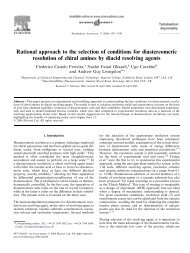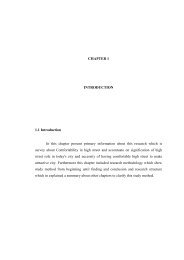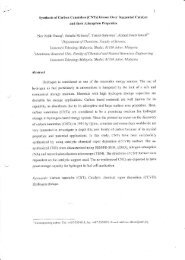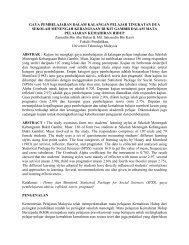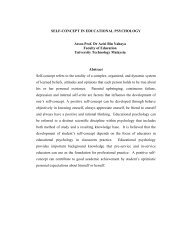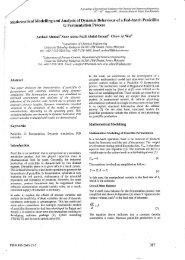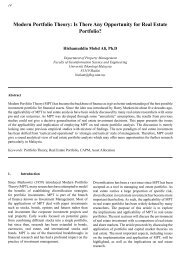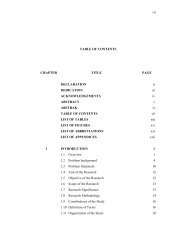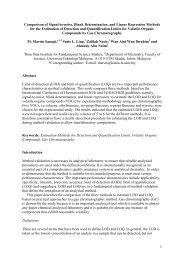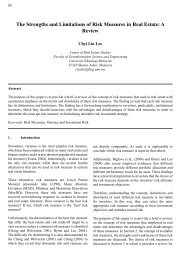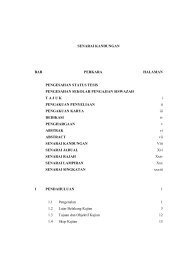CHAPTER 1 INTRODUCTION 1.1 Introduction Acoustic waves are ...
CHAPTER 1 INTRODUCTION 1.1 Introduction Acoustic waves are ...
CHAPTER 1 INTRODUCTION 1.1 Introduction Acoustic waves are ...
Create successful ePaper yourself
Turn your PDF publications into a flip-book with our unique Google optimized e-Paper software.
<strong>CHAPTER</strong> 1<br />
<strong>INTRODUCTION</strong><br />
<strong>1.1</strong> <strong>Introduction</strong><br />
<strong>Acoustic</strong> <strong>waves</strong> <strong>are</strong> the most important characteristic for convey data in<br />
underwater domain as a practical method. The mechanical vibration can propagate in sea<br />
easily, on the other hand electromagnetic (EM) and lightning signal have many limitation<br />
and losses, in counterpart <strong>waves</strong> that <strong>are</strong> in acoustic range has better in water environment<br />
[9], then newly acoustic signals has effected all data links and radars equipment in<br />
underwater communication field. <strong>Acoustic</strong> signals application divided by three part as<br />
shown in figure<strong>1.1</strong> [9] first detect and locate obstacles and target second features<br />
measurement of marine situation (sea bed topography, analysis of living creatures) and<br />
the last transmit and receiving signal of data which can carry information and commands<br />
between submarines, vessels, scuba drivers and all robots that <strong>are</strong> doing a special mission<br />
in sea floor.<br />
All communication systems and the media between them have faced noise. Then<br />
main noises in underwater environment <strong>are</strong> ambient noise, self noise, reverberation and<br />
acoustic interference [9], that can deform or damage message signal in communication<br />
systems cycle. The underwater noise analysis is essential for running every underwater
2<br />
field project and data link implementation and also underwater noises <strong>are</strong> base on passive<br />
sonar radars for detecting every target [16].<br />
Figure (<strong>1.1</strong>) : types of acoustic noise (1) Ambient noise; (2) self noise ; (3) reverberation;<br />
(4) acoustic interference; (5) expected target echo<br />
Current trend of research in underwater propagation channel modeling is<br />
developed by all types of noise field at dissimilar situation and diverse parameters such as<br />
depth, temperature, velocity, pressure. And by pattern noise modeling the researcher and<br />
engineers <strong>are</strong> able to optimum design of equipments and implement communication<br />
systems [12] .oil infrastructure and military systems and seabed topography <strong>are</strong> some<br />
context of noise modeling knowledge [16], can monitored by 2D or 3D graph by many<br />
simulator for instance Matlab and Python program.<br />
1.2 Problem Statement<br />
The thesis started with the stated limitations below which affect on the studying of<br />
the underwater noise impact to data communication link behavior:<br />
• Study on all types of underwater noise and focus on ambient and self-noise
3<br />
• Analysis of real man-made, ambient, and marine creature samples in time and<br />
frequency domain separately and receiving to time-frequency (STFT) graphs.<br />
• Develop underwater noise modeling which consist of a QPSK transmitter,<br />
receiver with additive underwater noise disjointedly in channel between them.<br />
• Performance evaluation of the model with different degree of noise level<br />
• Study of underwater noise behavior on QPSK data link communication<br />
1.3 Objectives<br />
points:<br />
The objectives and goals of this paper can be briefly summarized in the following<br />
• To Analyse of several underwater noise samples as a real noise sound wave.<br />
• To investigate change time and frequency characteristics of noise graph by using<br />
Matlab softw<strong>are</strong>.<br />
• To implement QPSK transmitter and receiver model by Matlab softw<strong>are</strong>.<br />
• To investigate BER due to different types of underwater noise on QPSK data<br />
communication link.<br />
• To recommend solutions to filter of each types underwater noise .<br />
1.4 Research Question<br />
• What <strong>are</strong> the underwater signal noises characteristics?<br />
• What can be done to solve high BER in QPSK underwater data link<br />
communication?
4<br />
1.5 Scope<br />
This project will be divided into four phases, they <strong>are</strong> described as follows:<br />
• Getting underwater sound signal from internet as a real samples.<br />
• Using MATLAB softw<strong>are</strong> to get the time, frequency and (STFT) of each under –<br />
water noise component.<br />
• Simulate QPSK communication data link by MATLAB softw<strong>are</strong>.<br />
• Adding samples noise to QPSK channel and evaluation of the BER model with<br />
different kind of noise.<br />
1.6 Limitation<br />
• Collect underwater different noises separately<br />
• The available time to gather information<br />
• The cost in carrying out the research as a practical project



